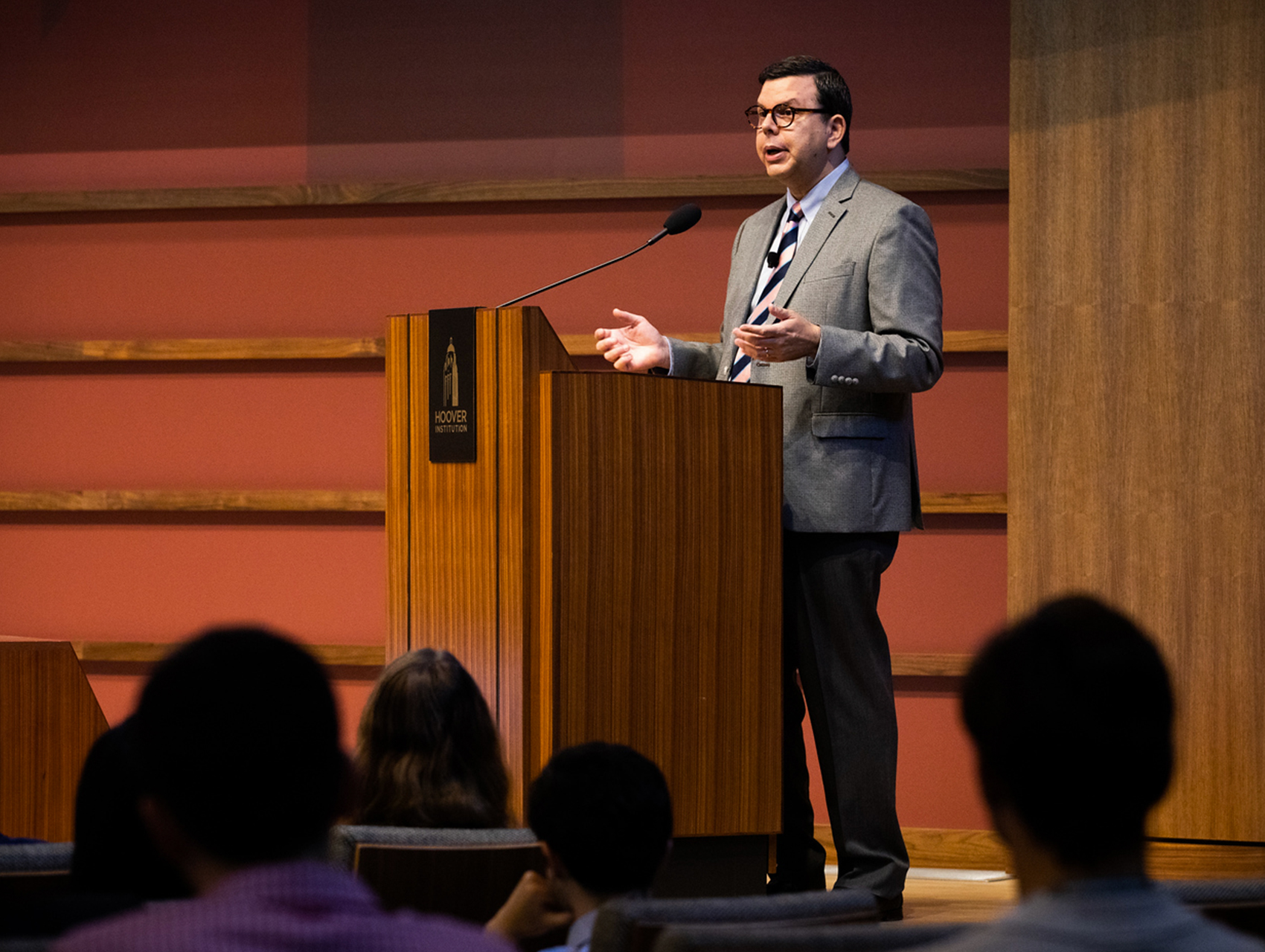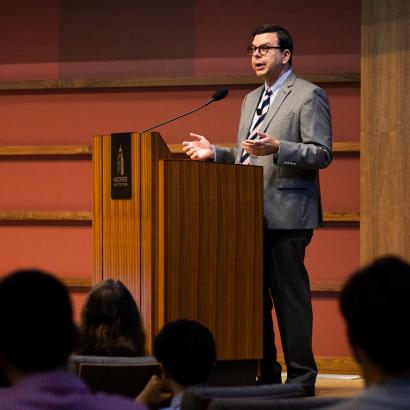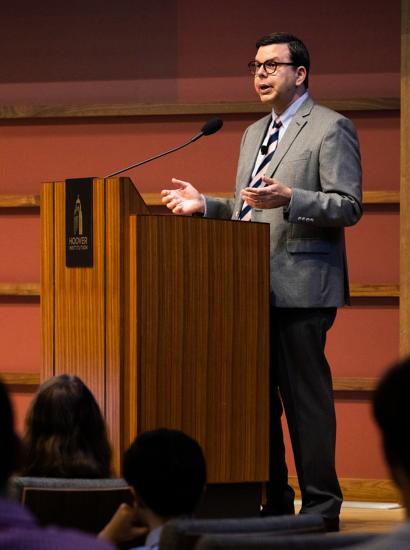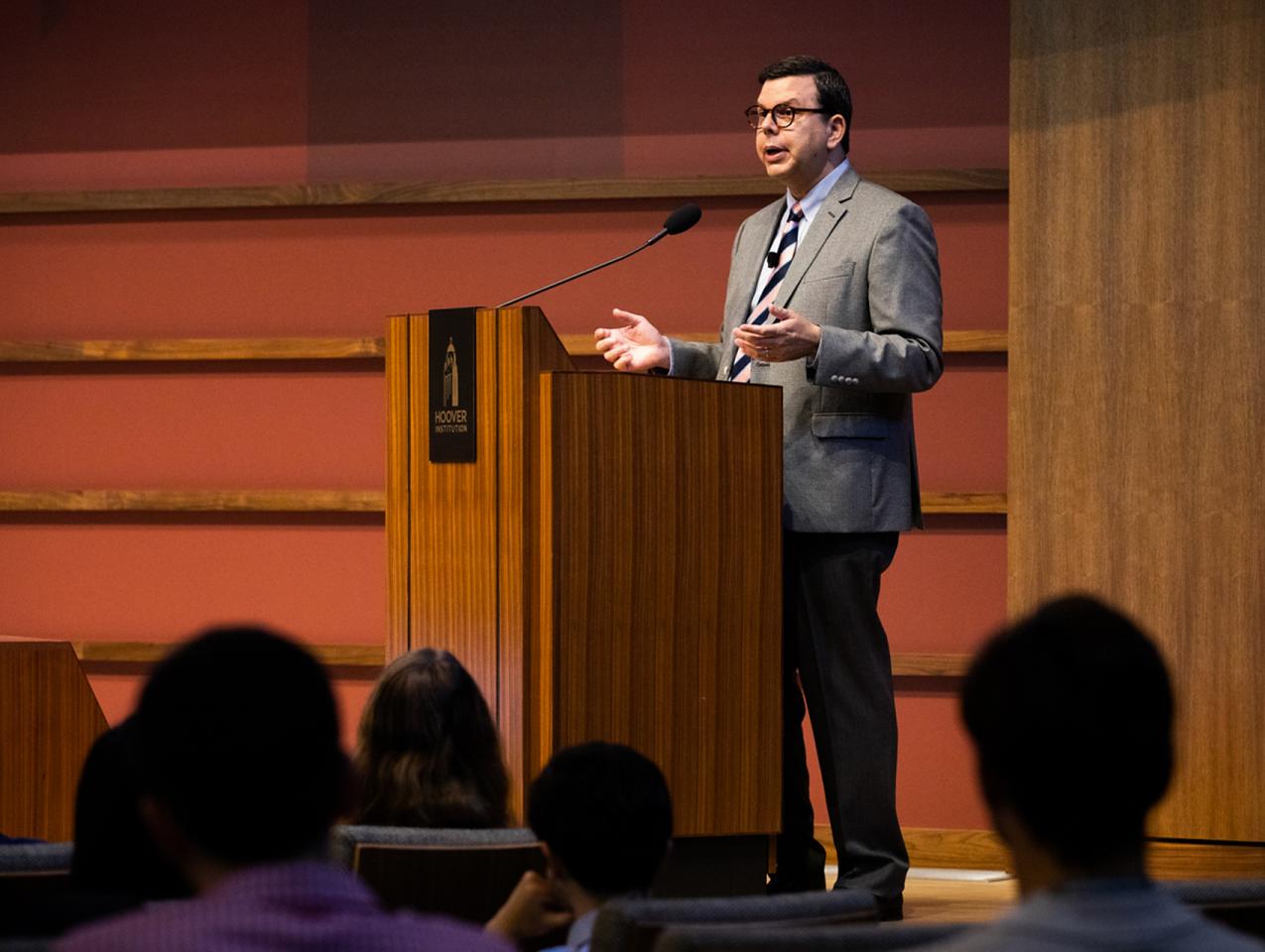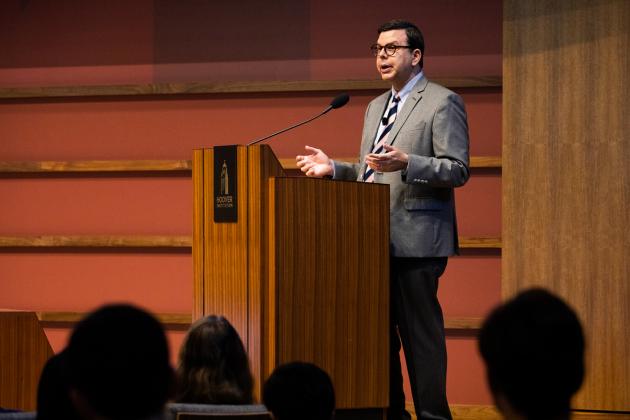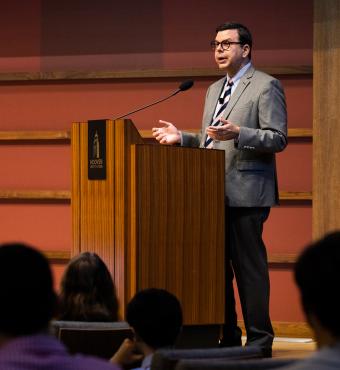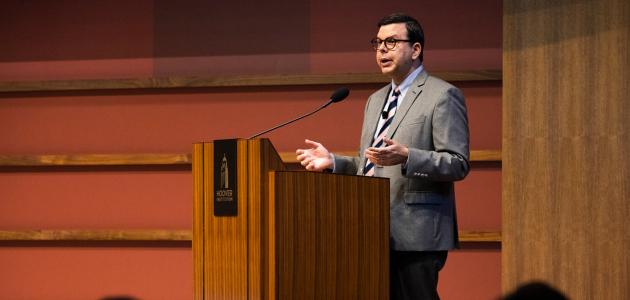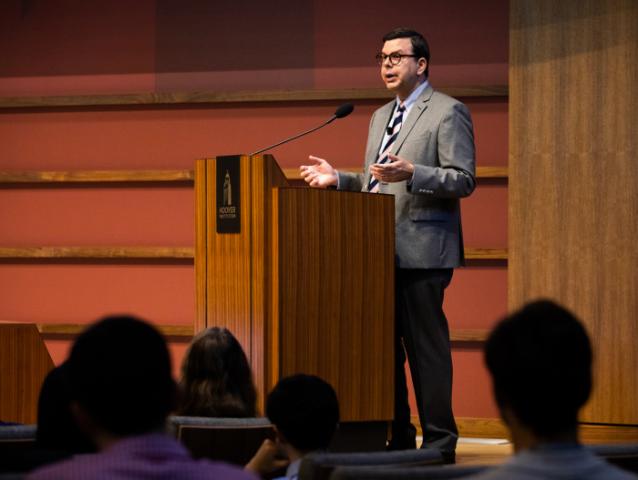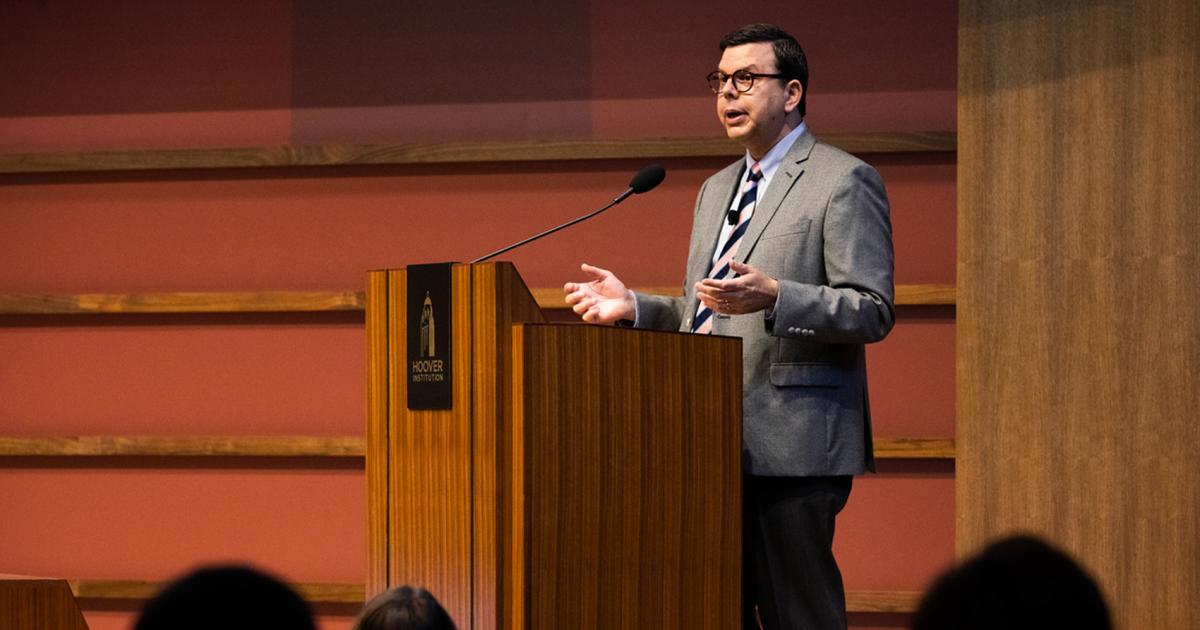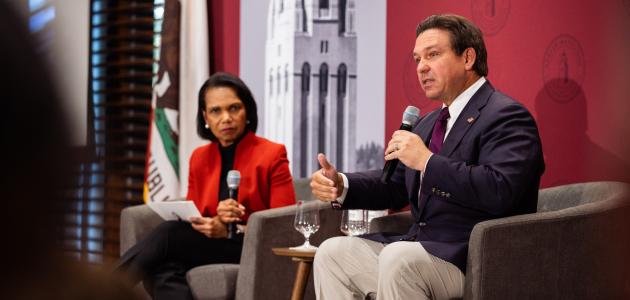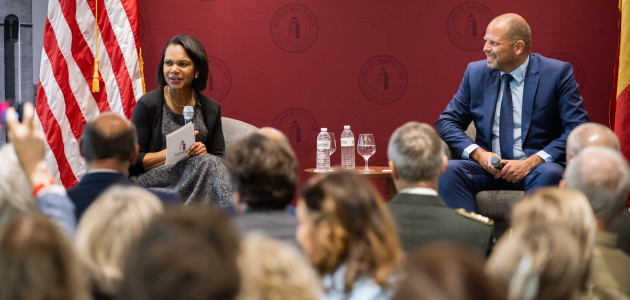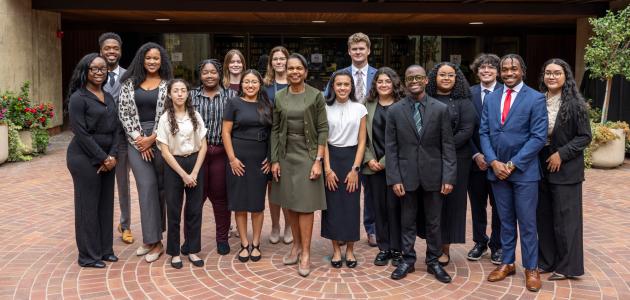By Jonathan Movroydis
David Leal is a senior fellow at the Hoover Institution and professor of government at the University of Texas at Austin. He is an expert in the fields of immigration policy, Latino politics, and the political implications of demographic change.
Few issues generate more controversy than immigration, and Senior Fellow David Leal has been researching and teaching the politics of immigration for over two decades. In this interview, Leal discusses the history and development of US immigration policies, the debates around illegal immigrants and refugees, the problems with numerical limits, the challenges facing enforcement efforts, the prospects for reform, and how Ronald Reagan’s optimism about immigrants is more relevant than ever.
Leal notes that welcoming newcomers is central to our “nation of immigrants” heritage as well as key to our economic growth and national security. He points out two worrying trends: our birthrates are declining, and millions of Americans have left the labor force.
A key problem, Leal explains, is that many of our current policies are contrary to capitalism and human nature, so we should not be surprised when they appear “broken.” For instance, the economy generates many jobs that Americans do not want and cannot fill, but we artificially limit the number of immigrant workers across all skill levels.
He advocates rational reforms that break away from dead-end partisan politics and focus on growing the economy, enhancing national security, and maximizing individual liberty. He also urges us to run, not walk, from conspiracy theories, such as the baseless claim that immigration is somehow a plot to “replace” Americans.
Leal discusses the limited impact of enforcement efforts; how to address refugee flows; and ideas for immigration reform. He argues that political debates about immigration often provide misleading choices. The issue is more complicated than suggested by simple contrasts like “conservative” vs. “liberal” or “tough” vs. “permissive” or “secure borders” vs. “open borders.”
Leal therefore urges policy makers to bring principled conservative, libertarian, and religious values to this debate instead of supporting an endless cycle of arbitrary restrictions, counterproductive regulations, and expensive enforcement.
Leal recalls that in his Farewell Address to the Nation, President Ronald Reagan said that America’s doors should be “open to anyone with the will and the heart to get here.” Leal believes it says something great about our nation that so many people around the world are still taking great risks to walk through those doors in pursuit of the American Dream. Immigrants want to achieve the American dream, he says, not change it, and they make us stronger through their work ethic, family values, and religious faith.
What is the big-picture history of immigration policy?
The story of US immigration policy is a story of the growth of the federal government at the expense of the states. If you like Big Government, then you will love America’s current immigration policies, which are filled with restrictions and regulations that are inconsistent with a free market society.
Immigration history is complicated, but for about a century after independence the United States basically had no immigration laws, so anyone could move here. The journey may not have been easy, but no visas were necessary, and there was no enforcement bureaucracy because there were no laws to enforce.
In fact, the Constitution did not directly give the United States the power to regulate immigration, only the authority “To establish an uniform Rule of Naturalization” (Article I). Almost immediately, the 1790 Immigration Act restricted naturalization to “free white persons,” so we have to acknowledge that race has been part of migration politics from the start.
Federal power to regulate immigration would ultimately be recognized as intertwined with sovereignty, even if there is no clear constitutional provision. As Justice Scalia reflected in United States v. Arizona (2012), such regulation is “a valid exercise of federal power—not because of the Naturalization Clause … but because it is an inherent attribute of sovereignty no less for the United States than for the States.” Nevertheless, the Constitution did not impose any immigration restrictions, nor did it require the federal government to enact any such laws.
In these early decades, individual states attempted to regulate immigration as part of their “policing” powers, with exclusions involving poverty, criminality, morality, and race. This policy environment began to change in the second half of the nineteenth century and the early twentieth century with the enactment of new federal laws and enforcement practices. As immigration came to be seen as a federal “plenary” power, the national government would ultimately decide who could, and could not, be admitted and removed. Nevertheless, we should keep in mind that an entirely constitutional reform idea is to give states a greater role in immigrant admissions.
At the federal level, the Chinese Exclusion Act (1882) sought to do what its name suggests; the 1891 Immigration Act created a list of exclusions, including “idiots,” the “insane, “paupers,” those “likely to become a public charge,” individuals with “loathsome” or “contagious” diseases, felons, and polygamists. The Immigration Act of 1903 excluded anarchists, beggars, the epileptic, and prostitutes. And the Immigration Act of 1917 enacted a literacy test and created the “Asiatic Barred Zone” (again, the name indicates the goal).
By the way, I’ve never been sure how immigration officials knew who was an anarchist, but presumably it was a bad idea to start handing out literature on Ellis Island. In practice, few individuals were apparently excluded, although some immigrant anarchists were deported.
The capstone of this creeping nativism was the Emergency Quota Act of 1921 and the Immigration Act of 1924, which limited migration numbers in a way blatantly designed to reduce the numbers of Catholic migrants from Eastern and Southern Europe. The 1924 law also banned Japanese migration, thus codifying the informal US-Japan policy known as the “Gentlemen’s Agreements.” The Border Patrol was created in 1924, not to stop Mexican and Latin American migrants, who were exempted from the 1920s limitations, but rather other migrants who tried to evade restrictions by crossing the southern border.
In the mid-1960s, America’s immigration policy underwent another dramatic change. The 1965 Immigration and Nationality Act, signed by President Lyndon Baines Johnson, ended the discriminatory 1920s quotas. It refocused our immigration policy around two aspects: family reunification and the economy. The law created a total yearly cap, with no more than 20,000 individuals from any one nation, but there was no limit to immediate family reunification visas, which would prove to be a significant source of migration numbers. Although a variety of immigration laws have since been passed, we are still living under the fundamental framework created by the 1965 law.
Today, while American immigration law includes many restrictions, and we spend lots of money on enforcement, we are also a generous nation. In the years prior to the pandemic, approximately one million people received legal permanent residence (LPR) status per year, and about eight hundred thousand became citizens every year. This generosity is in our own national interest, of course, as I will discuss. And while one million may sound like a lot, in a nation of over three hundred and thirty million, it constitutes less than one-third of 1 percent.
Nevertheless, when you compare today’s immigration laws and policies with those of earlier periods, we have far more regulations and restrictions, considerably greater enforcement efforts, and a much larger bureaucracy. Some states have also tried to get into the restriction and enforcement act. We would do well to reconsider those aspects of federal (and state) laws that are expensive, counterproductive, and intrusive.
This is not to argue that any and all immigration laws are illegitimate, as reasonable people can debate the ways and means of migration. Nevertheless, many of our current policies are politically and economically problematic, so we should bring the “deregulation” mindset—so strongly associated with Ronald Reagan—to immigration reform.
Why do so many politicians say that immigration policy is “broken”?
When Big Government creates laws and policies that are contrary to the free market and human self-interest, the results will often look “broken,” and for good reason. But the fundamental problem is not immigration itself but rather how the United States tries to artificially regulate and restrict it.
For example, our economy creates a lot of jobs, but our birthrates have declined and many Americans have left the labor force. Employers therefore need more workers in many skill categories than the native-born population can produce. Businesses therefore quite rationally turn to immigrants, and they are impatient with artificial government classifications like “legal” and “illegal.” They need to turn a profit and stay open, and many have little choice but to hire immigrants without legal status (who are varyingly called illegal, unauthorized, or undocumented).
Many of these workers are from Mexico and Latin America. In the past, they would have been completely “legal” because the United States was not trying to stop them. But today, restrictive federal laws make them “illegal” and thereby create a problem that did not previously exist (in other words, a classic example of Big Government).
If we had immigration laws that better reflected economic reality, there would be many more visas for the immigrants eager to take the jobs that Americans do not want and cannot fill. Because our laws do not, immigrants cross over anyway and employers turn a blind eye. Without this migration, our economy would be hurt, but the system looks “broken” because laws and economic reality are in conflict.
The solution to fixing our “broken” immigration laws is to enact reforms that work with capitalism and human nature, not against them. The real immigration “crisis” is not that so many people want to move here but that our policies allow too few workers to migrate legally.
You said that the birthrate in America has declined. Are we facing a demographic collapse that is resulting in an urgent need for immigrants?
Our population numbers will start to decline without immigration, and there is little doubt that our economic growth and national security are connected to the size of the country. This challenge will unfold throughout the twenty-first century. While we do not face an immediate demographic cliff, we don’t want to slowly but surely undermine our economic and military power through population stagnation.
As I mentioned, our economic growth is at risk because of the lower birth rates and reduced labor force participation of the native born. America needs more people, and many people want to migrate, so we should be welcoming them. It only hurts us to implement arbitrary numerical restrictions and to deport immigrants who are already working in jobs that Americans don’t want and who are otherwise obeying everyday laws.
Immigration is also crucial to our international power. We do not want to be in the position of China, which—as the Hoover “GoodFellows” team points out—has “long-term demographic challenges (an aging population overtaking a contracting workforce).” In Russia, as we have seen recently, “demographic constraints are gradually but unforgivingly restricting the realm of the possible for the Russian state on the international stage.” Our ally Japan has low rates of immigration and declining domestic birth rates. It is projected to lose tens of millions of people by the end of the century, which will reduce its power.
Even before America became a nation, we recognized the importance of migration and population growth. One of the criticisms of King George III in the Declaration of Independence was that he obstructed migration to the colonies:
He has endeavoured to prevent the population of these States; for that purpose obstructing the Laws for Naturalization of Foreigners; refusing to pass others to encourage their migrations hither …
Today, nobody but ourselves is obstructing the “migrations hither” so essential to our economy and security.
Is an immigrant “invasion” taking place along the southern border?
I’m not the first to observe that “invasion” is a misleading metaphor. The word indicates a military operation centrally directed by a government with the intention of causing destruction and defeat of an enemy. Migration, by contrast, is rooted in individuals making decisions about what is best for themselves and their families. When immigrants enter the United States, they make our nation stronger and richer. Conspiracy theorists allege that immigration is somehow a plot to turn America into Cuba or something, but principled conservatives should avoid this kind of paranoid malarkey.
If we want to see a real invasion, we can go to the Ukraine. But if we want to meet people who will work hard, start businesses, fill church pews, and raise families, we should go to the US-Mexico border.
When people want to be Americans, this is not a fundamental crisis; a genuine crisis would be millions of Americans trying to leave. When Mexicans, Latin Americans, and others seek to improve their lives and live safely, they turn to the United States. Despite what you hear on social media and cable news, the American Dream is alive and well, and our nation remains a beacon to the world.
Here’s a historical analogy, although it may be “politically incorrect” because it compares people with objects. Nevertheless, I would argue that there is no more an immigrant “invasion” at our southern border than there was a whiskey “invasion” at our northern border during Prohibition. In both cases, Big Government passed laws that were contrary to human nature and bad for the economy. We should not be surprised that many people ignored them.
The entirely predictable response to Prohibition was that alcohol flowed illegally across the border—remember the opening scene of the movie The Untouchables? Today, when our immigration laws prevent foreign workers from taking jobs that Americans do not want or cannot fill, the result is clandestine migration. In both cases, the logic of capitalism and individual self-interest triumphs over the efforts of government to regulate the labor market and tell people how to live. And as we saw during Prohibition, restrictive laws actually create the illegality and chaos that critics decry.
How do you respond to critics who claim that immigration has become a plot to increase the Democratic vote?
This is the conspiracy theory called “the great replacement” or “replacement theory.” It claims that immigration is somehow being deliberately encouraged in order to increase the minority population of America, with the object of shifting politics in a more progressive direction.
It’s all hogwash, of course. One key problem is that immigration is not simply directed by politicians or political parties. Immigration starts fundamentally with the individual. That is why principled conservatives, who believe individuals and families should be the building blocks of society, should understand that immigration is not just created by laws but flows from individuals making decisions that advance their interests. And these individuals have no interest in “replacing” anyone or doing anything other than achieving the American Dream.
It also takes a long time before immigrants are able to vote, and many never can or never will. If you are an illegal immigrant or in a legal but noncitizen category, you cannot vote. Those who obtain a “Green Card” and receive legal permanent resident status (LPR) must still wait five years before they can apply for citizenship. Many never do, however. Less than half of eligible Mexican immigrants become US citizens, and those who do take ten years on average (twice the minimum wait).
Even after becoming citizens, they must then register to vote, and then actually vote. The number who complete all these steps is not large. So, the claim that immigration today will have immediate political effects is wrong. Even if every unauthorized immigrant were legalized, one Hoover Institution study indicates that the impact on electoral politics would be “small.”
Another myth is that immigrants are coming into America with fundamentally different political values, but this doesn’t reflect reality. As I said, they come to America to achieve the American Dream, not to change it. They are not trying to bring socialism or any other “ism” to America, as many are fleeing failed socialist regimes. And we see much assimilation despite claims to the contrary by nativists and conspiracy theorists.
For example, as I have been pointing out for several years, the Latino vote has more potential for the GOP than many realize. Today, Latino voters are increasingly in the news, and not because of any socialism but because of their growing support for Republicans. We recently saw Mayra Flores, a Latina Republican and herself a Mexican immigrant, flip a South Texas congressional district in a special election. We also witnessed increases in Latino support for Donald Trump in 2020, despite claims by liberal activists, academics, and journalists that he would drive Latino voters into the arms of the Democratic Party. In the recent midterm elections, the GOP continued to make gains with Latino voters, and a South Texas congressional district elected Latina Republican Monica De La Cruz. The idea that Latinos are dedicated Democrats who will shift America in a more progressive direction is increasingly contradicted by the reality on the ground.
Some conservative commentators are understanding this, including Rich Lowry and Douglas Murray. As I have been suggesting, growing Latino populations may prove to be an opportunity for the party, not an obstacle. A recent story in the Dallas Morning News, headlined “Republicans Pin Hopes on Latino Vote in Rio Grande Valley,” would have been inconceivable not long ago.
Historically, the political effects of immigration on the political future have always been less than anticipated. We have seen large-scale immigration before, but assimilation was powerful, and immigrant communities moved slowly but surely to the political mainstream. Irish and Italian immigrants may have initially voted Democratic, but their descendants are now more Republican than Democratic. We may already be seeing a similar dynamic play out with Latinos.
How do claims about illegal immigrant voting fit into the mythologies you mentioned above?
We sometimes read claims that many illegal immigrants vote in American elections, but this is a myth that verges on conspiracy theory. Despite what you may hear on social media or cable news, there is no evidence of any kind of widespread and organized fraud involving noncitizens. We have a voter registration system that works well, and elections are administered smoothly and competently at local (and not national) levels of government, consistent with traditional conservative principles. The main problem with voting in the United States is not that illegal immigrants supposedly vote but that so many American citizens do not choose to exercise this fundamental right.
In the few instances when noncitizens are caught voting, my impression is that they tend to be accidents or misunderstandings, not deliberate, organized fraud. And let’s be realistic: illegal immigrants have a lot of problems living their everyday lives, so if you were one, would you try to vote and risk calling attention to yourself?
Speaking of LPR status, under what criteria do our immigration officials admit, or deny admission to, individuals seeking to enter the country?
There are many pathways to the United States, most temporary and some permanent. It’s a complicated system, but I’ll try to summarize the basics.
In a normal year, millions of people temporarily visit the United States. They receive a wide range of “nonimmigrant” visas, and it’s quite an alphabet soup. The most common is the B-2 tourist visa (over five million in 2019), but there are visas for students (F), persons engaged to US citizens (K), intercompany transfers (L), NATO officials (NATO), religious occupations (R), Commonwealth of Northern Mariana Islands Transitional Workers (CW), and many other classifications.
A smaller number receive a Green Card, which provides legal permanent resident (LPR) status. As the name suggests, this entitles recipients to live in the United States indefinitely, and they can apply for citizenship after five years, although many do not. About two-thirds of those who are granted a Green Card do so through sponsorship by relatives who are citizens or LPRs. A smaller share (only about 15 percent) receives it through the employment-based preference system, and about the same percentage receives one through refugee and asylum categories.
Employment-based immigrants include highly-skilled individuals who are sponsored by an employer. For example, the H-1B visa program is limited to sixty-five thousand people per year, and visas go fast. Long before a year is over, they will all be used up. We could certainly expand this program because it would fill a workforce need. Evidence suggests that when businesses can’t bring over highly-skilled workers, they look to offshore the work. Consequently, the numerical limitation only harms the economy.
Most low-skilled workers have relatively few options, especially for permanent residency. For instance, agricultural and some seasonal workers can receive a temporary work visa through sponsorship by an employer who is willing to jump through bureaucratic hoops. However, the annual number of permanent (Green Card-eligible) unskilled workers who can be sponsored by employers is limited to ten thousand, which is a drop in the workforce ocean.
While we sometimes hear that immigrants should “get in line,” if a Honduran wants to mow lawns in Denver, or a Guatemalan wants to work as a nanny in Dallas, there is no line they can just join. Such workers therefore often migrate without authorization.
From the principled conservative perspective, such movement is the free market in action, as businesses have jobs to fill, and immigrants want to fill them. Adam Smith famously wrote about an “invisible hand” that appears to guide the economy, and we might envision this invisible hand as waving immigrants across the border to meet the labor needs of many economic sectors.
The government tries to restrict such movement, but this top-down interference in labor markets rarely succeeds. It mostly creates negative externalities, putting employers in difficult positions and imposing significant costs on immigrants themselves who undertake an often-dangerous journey.
Refugees are admitted up to an annual limit set by the president. The diversity visa lottery, which is for individuals in nations that historically sent few migrants to the United States, has a limit of about fifty-five thousand. Some visitors are allowed temporary protected status (TPS) when it would be problematic to require them to return to a nation that has, for example, been recently devastated by a hurricane.
A more rational immigration policy would significantly increase the number of visas for all kinds of workers: if the economy needs them, let them migrate. The rhetoric about “skilled” vs. “unskilled” is a counterproductive distraction. If our economy is to remain strong, we need more workers of many types.
This increase should not come at the expense of family-sponsored migration. According to traditional religious and principled conservative values, the family is foundational to society. This applies to both new and old Americans. I’m not the first to observe that we want immigrants to live within a family unit, as it is better for their success and integration, and it is better for society as a whole. Why would we admit immigrants as individuals but prevent them from reuniting with family members who also want to be Americans?
If there is growth in these industries and there is obviously a demand for low-skilled labor, then why would those people be denied entry?
Because we have a lot of myths about immigrants. For instance, we often hear the claim that immigrants are competing with native-born workers for jobs. The truth is that immigrants take many jobs that Americans do not want. A term for some of this work is the “Three D’s,” which means dirty, dangerous, and demeaning. These jobs also pay poorly and have few if any benefits. Not many Americans want such work. From the perspective of an immigrant, however, they can be the first step on the path to the American Dream.
Immigrants rarely compete with native-born Americans for hard, low-paying agricultural, construction, and service jobs. They are more likely to compete with the immigrants who came right before them, as they are looking for the same type of work.
Another myth is that immigrants are a significant drain on public services. While the costs can vary from place to place, we should keep in mind that immigrants as a group pay taxes and contribute to economic growth. Many immigrants, legal or not, are also paying taxes for programs they cannot access. Some point to the costs of public education for the children of immigrants, but many of them are American citizens, and we have every self-interested reason to invest in their education. And if anyone thinks that America would be a better place if we denied education to any children, then we are just going to have to disagree.
Low-skilled immigrants are also seen as people who are more likely to use government social welfare programs. The fact of the matter is that many such immigrants are unauthorized and therefore have little or no access to these public services. Various immigration laws starting in the 1990s have significantly curtailed noncitizen access to such programs.
The right balance may be to admit many immigrants but only allow them access to social programs if and when they earn citizenship. This would be consistent with the insights of Milton Friedman, who saw illegal immigration as good for immigrants themselves and for the nation as a whole—but only if it is illegal, because then they cannot access social welfare programs. As William Niskanen argued, the solution is to “build a wall around the welfare state, not around the country.” We have already done much of this, as unauthorized immigrants can access few federal social programs.
What are some ways in which the immigration debate goes wrong?
I want to highlight how immigration is commonly discussed. Most politicians, pundits, and journalists have a limited vocabulary when it comes to the immigration issue. They see policies as either “liberal” or “conservative,” but this is too simplistic. They should add the following word to their lexicon: “libertarian.”
Many conservatives already claim to be sympathetic to libertarian ideas, but when it comes to immigration policy, they often forget about them. Conservatives should take more seriously libertarian ideas about the relationships between human mobility, government power, and individual freedom.
For principled conservatives, here are some thoughts to ponder.
Many conservatives say they want limited government—but when it comes to immigration, some are OK with a powerful government that reshapes the economy and society.
Many conservatives say they want fiscal responsibility—but when it comes to immigration enforcement, some support spending billions of taxpayer dollars without much to show for it.
Many conservatives say they believe individuals and families are the building blocks of society—but when it comes to immigration, some want government to stop individuals from acting in their self-interest and support policies that split families apart.
Many conservatives say they believe in traditional Christian values—but when it comes to immigration, some ignore the biblical injunction to “welcome the stranger” and forget that Jesus and the Holy Family were once refugees in Egypt.
A principled conservative approach to immigration policy would be aligned with capitalism and human nature, build on our “nation of immigrants” tradition, be consistent with religious values, understand that top-down government regulation cannot be the answer, and avoid paranoid conspiracy theories.
Then how can conservatives better align their core values with their immigration policy views?
First, I would suggest that conservatives become more familiar with immigration laws. For example, many say that prospective immigrants should “get in line,” but as I said above, the reality is that few such “lines” exist. If you live in Guadalajara and want to install roofing in a Phoenix suburb, there is no “line” you can simply join.
Second, I would recommend that conservatives spend more time looking for reliable research on immigrants. We hear many false claims on social media and cable news, but the truth is not difficult to find. For example, many pundits say that immigrants, and especially Latinos, don’t assimilate, but academic and think tank research shows that this is not true. Immigrants continue to assimilate and move to the mainstream across all political, social, and economic dimensions. This is actually good news for conservatives, as it shows that the classic American melting pot continues to work, and that today’s immigrants are adopting our core values, just as immigrants did in the past. So not only does nerdy, data-oriented analysis dispel myths and falsehoods, it can also increase our optimism about America and its future.
For factual, reality-based perspectives, look to Hoover scholars such as John Cochrane, Tim Kane, and Condoleezza Rice (in addition to yours truly) as well as Cato Institute scholars including Alex Nowrasteh, Ilya Somin, and David Bier.
Third, conservatives who believe in capitalism, limited government, religious faith, and individual liberty should try to bring those values to the immigration debate. It is a serious problem to say, “We believe in these fundamental values, but when it comes to immigration, we want big, expensive, illiberal, and counterproductive government.”
Fourth, when we hear nativists and populists making false and negative claims about immigrants and urging top-down government “solutions,” we need to understand that these are not conservative voices. The word “conservative” is much debated today, and while nativist-populists may try to claim the label, there is no reason for principled conservatives to agree. Anti-immigration activists are not conservative in the way Reagan was conservative; they are better understood as radicals who are trying to socially engineer society in ways that will make us poorer and less free.
With apologies to Spiro Agnew—whose father, by the way, was a Greek immigrant—principled conservatives should ignore the nattering nabobs of nativist negativism.
Does immigration enforcement actually work?
The short answer is no, and for all the reasons that conservatives can understand.
When Big Government tries to force individuals and businesses to act in ways that are contrary to their self-interest, they naturally look for ways around those policies. Principled conservatives instinctively understand this, but they sometimes fail to apply this knowledge to the immigration issue.
Too many people think our policy choices are “toughness” vs. “permissiveness,” but those are false frames. They did not work for alcohol and will not work for immigration. Prohibition, which I mentioned above, was one of the greatest policy failures in American history, as it tried to stop people from doing what they wanted. And I’m sure nobody reading this essay ever drank a beer before the age of twenty-one.
If the classic definition of insanity is doing the same thing over and over and expecting different results, then our immigration enforcement efforts certainly qualify. But anti-immigration activists continue to demand that we build more walls, hire more enforcement agents, and throw more billions of taxpayer dollars at the issue. We’ve been doing that for decades, however, and it does not have the intended effects. The number of unauthorized immigrants remains fairly constant regardless of enforcement efforts, and the only factor that appears to reduce this number is the state of the economy. For example, the number of such immigrants from Mexico declined considerably due to the Great Recession. In other words, immigration is intertwined with capitalism, and our immigration policies should therefore reflect economic realities.
People are arriving today in large numbers from Central America, Venezuela, Cuba, and other nations because political and economic crises are “pushing” them out while American capitalism and opportunity are “pulling” them to our nation. More immigration enforcement efforts will not change these fundamental factors.
Sure, immigration enforcement agents can find individual illegal immigrants and deport them, even large numbers of them. But that has no effect on the big-picture economic and political forces that shape migration. And to substantially reduce the illegal immigrant population that is already here would require an enforcement regime that would almost be a police state. This would be contrary to core American notions of liberty and would significantly harm the economy. Do you really want to have to carry your passport and prove your citizenship whenever and wherever some official demands it? We all lose from that sort of Soviet-style “papers please” enforcement.
We also have to ask why we would want to deport people who are staffing local stores and restaurants, working at construction sites, mowing lawns, caring for children, and doing all the jobs Americans don’t want. Illegal immigrants are humans who are working in jobs that were offered by American businesses. They are just trying to improve their lives and create a better world for their children. They are building the economy, growing the tax base, filling church pews, and in most ways living like ordinary Americans.
The only reason they are “illegal” is because federal law imposes that label. In our nineteenth-century era of more libertarian immigration policy, they would have been legal because there were no federal immigration laws. As principled conservatives can appreciate, we might look to the past in order to help solve the self-created problems of the present.
What about the border wall?
Politicians love them or hate them, but this political noise means little. Border walls have no effect on the fundamental factors that determine migration.
More generally, immigration deterrence and enforcement policies can be considered examples of political “theater” meant to fool voters into thinking that elected officials are doing something useful. A book with the apt title of Border Games captures this dishonest politics. Border walls can look impressive but are mostly vote-getting gimmicks.
Despite the controversy over Trump’s border wall, support for such barriers was bipartisan until recently. For example, the Secure Fence Act of 2006 extended US-Mexico border barriers by seven hundred miles and passed in the Senate 80–19. Among the yea votes were senators Hillary Clinton and Barack Obama. Then came Trump, and Democrats denounced his border wall extensions as dangerous, demagogic, etc. The fact that Trump, Clinton, and Obama all found it convenient at certain points to support border barriers should tell you something about whether they are more about public relations than effectiveness.
Furthermore, a growing number of immigrants arrive legally but then lose legal status when their temporary visas expire. These “visa overstayers” originally enter the US via a student, tourist, or other temporary visa but fail to return home. Border walls have no effect on their numbers.
But can’t walls stop the smuggling of drugs across the US-Mexico border?
Nobody loves the irrational aspects of America’s immigration laws more than drug smugglers.
Because we do not admit nearly enough migrants to meet economic needs, federal law takes immigrants who would be happy to enter legally and turns them into illegal immigrants. In the past, America had lots of “circular migration,” whereby immigrants spent time legally working in the United States but often returned home and invested their earnings. When we changed the law to make this movement illegal, the age-old migration patterns continued because American growers and business owners still needed workers. Now, however, these journeys often become one-way because of the difficulties and risks of crossing a more fortified border.
The movement of illegal immigrants creates challenges for law enforcement, which is legitimately tasked with stopping criminal activity and security threats. It’s a difficult job under the best of circumstances, but our immigration laws make it harder—and almost impossible. Law enforcement is so busy chasing people who just want to work and live safely in the United States that it cannot focus on the true bad guys. If we created more legal pathways for the former, then law enforcement would find it much easier to catch the latter.
Ten years ago, President Obama signed an executive order, Deferred Action for Childhood Arrivals, or DACA. In 2017, President Trump entertained extending DACA through congressional legislation in exchange for support on the construction of the border wall. At this point in time, given how polarized the parties are from each other and economic uncertainties, is there hope for some type of bipartisan and comprehensive immigration reform?
It will be difficult to pass a large, complex reform bill, which is why some have talked about piecemeal reform, such as resolving DACA first.
Our last major immigration reform was the bipartisan Immigration Reform and Control Act (IRCA) in 1986. Its sponsors were Sen. Alan Simpson (R-WY) and Rep. Romano Mazzoli (D-KY). Signed by Ronald Reagan, it is an example of comprehensive immigration reform. The bill ultimately legalized almost three million people, enabling them to come out of the shadows. It also boosted funding for immigration enforcement and created “employer sanctions” for those who hired unauthorized immigrants, but these last two features did not really work.
A common critique of IRCA is therefore that the legalization happened but the enforcement didn’t. This shapes how politicians think about comprehensive immigration reform today. Some say, “Well, if we have a legalization that is packaged with increased funding for enforcement, is there any reason to think the enforcement would work this time?” That’s why some politicians and pundits claim we need to “secure the border” before any type of amnesty. However, as I discussed before, top-down migration restrictions face the obstacles of capitalism and human nature, so ending illegal migration in this way is a chimera that will never happen.
Another challenge to reform is that anti-immigration politics are back. Not only do we see conspiracy theories on social media and cable news, but some politicians are unfortunately using the immigration issue as a political football. I do not believe most of those politicians actually believe what they are saying, but they want to win their primary and general elections, so they approve television commercials and other messages that do not appeal to our better angels.
However, it’s unclear whether politicizing the immigration issue actually helps on Election Day. The Wall Street Journal once called this the “fool’s gold” of politics, and real world results cast doubt on whether it appeals to many voters.
It must be said that today’s parties are establishing clear differences on the immigration issue, with Republicans the most skeptical and Democrats the most favorable. Not long ago, however, Republican presidents and presidential candidates were taking the lead in welcoming immigrants, and hopefully we will eventually return to that status quo. In the meantime, the polarizing negativity about immigrants makes compromise legislation all the more difficult, and I’m not sure either party is capable of voting for rational reform. Republicans are worried they will be “primaried” if they are seen as insufficiently “tough,” while Democrats have the opposite problem.
This may sound surprising, but the best hope for immigration reform could be a politician like Donald Trump. If he decides to endorse some type of compromise plan, this would provide political cover for Republican members of Congress who support it. I can’t think of any other political figure who could credibly say to immigration skeptics, “This bill is not perfect, but it makes useful progress and strengthens the nation.”
The DACA recipients are those immigrants brought without legal status to the United States as children. They are known as “Dreamers” because of the proposed Development, Relief, and Education for Alien Minors (DREAM) Act, which would legalize their status. If there is any group of people who deserve some all-American compassion, it is those who did not choose to cross any border. Many of these “Dreamers” have only known the United States. Many of them don’t speak the language of their birth nations. Some only discovered they were not citizens when they finished high school and wanted to get a job, join the military, or attend college. Imagine what it must feel like to hear the words “Actually, you were not born here and are not a citizen.”
As I said before, immigration reform is also an opportunity for the United States to manifest its religious values. In a recent statement, the US Conference of Catholic Bishops pointed out “the need for congressional action” and asked “Congress, Republicans and Democrats alike, to provide a permanent solution for all Dreamers out of respect for their God-given dignity.” The Southern Baptist Ethics & Religious Liberty Commission “called for Congress to provide a long-term solution for undocumented immigrants brought to the United States as children,” adding that “Dreamers are invaluable members of our churches and communities, and they will continue to live in uncertainty as long as Congress delays.” The Mormon Church called upon “our national leaders to create policies that provide hope and opportunities for those, sometimes referred to as ‘Dreamers,’ who grew up here from a young age and for whom this country is their home. They have built lives, pursued educational opportunities, and been employed for years based on the policies that were in place. These individuals have demonstrated a capacity to serve and contribute positively in our society, and we believe they should be granted the opportunity to continue to do so.”
You wouldn’t know it from most media coverage, but President Trump said some positive things about the Dreamers. No legislation ultimately resulted, and one obstacle is that many falsely believe that “demography is destiny.” According to this theory, every new citizen is a new Democratic Party voter. As I have argued elsewhere, this is a problematic belief, but one held by many Republicans and Democrats alike. It’s just that Republicans fear it and Democrats welcome it. Both sides are wrong, as Latinos are already assimilating into the mainstream and will likely have no more permanent effect on American politics than did previous waves of immigrants.
Regardless of how the Supreme Court rules on DACA, the best way to secure Dreamers’ status is through law, passed by Congress and signed by the president. Then we can further work on making our immigration laws more rational, meaning more in tune with economic reality.
How does immigration enforcement hurt the political and economic liberties of citizens?
In terms of politics, if you spend time listening to nativists and anti-immigration activists, you will soon realize that many want an interior enforcement regime straight out of the Soviet Union. As I mentioned above, get ready for KGB-style “papers please” policies, whereby officials can stop you while driving, walking the dog, shopping, or doing anything, and make you prove your citizenship, on pain of arrest.
Why, you ask, should a free people have to carry a passport and show it to government officials on demand without probable cause? Good question.
In terms of economics, Ilya Somin of George Mason University and the Cato Institute recently investigated the implications of immigration restrictions for the economic liberty of native citizens. He finds that “the idea that such effects exist is far from a new one. But this article examines them in greater detail and illustrates their truly massive scale. It covers both the libertarian ‘negative’ view of economic freedom, and the more ‘positive’ version advanced by left-liberal political theorists.” In fact, the harmful effects on “negative” liberty from immigration restrictions are “probably more than any other government policy enacted by liberal democracies.”
In short, the nativist impulse toward endless immigration restrictions, regulations, and enforcement only harms the fundamental freedoms and economic prosperity of all Americans.
How should the United States deal with refugees?
Many conservatives who believe in the Reagan legacy are strong advocates of personal responsibility. As a nation, we need to acknowledge our responsibilities when it comes to refugees. The fact of the matter is that the United States has long been involved in the politics and economies of Mexico, Central and South America, and the Caribbean. Since the Monroe Doctrine of 1823, we have officially claimed a special interest in, and therefore a unique responsibility for, this hemisphere.
This is not to blame America for everyone’s problems, but we have had economic, political, and military relations with the region for two centuries. As we have been the more powerful party in these relationships, we have a duty to work productively and cooperatively with these nations.
Today, one of the key problems in the region is the violence and instability caused by drug cartels. We are not bystanders to this, as drugs flow north to American buyers, and our guns flow south to the cartels. The result is refugees who just want to live safely, and the United States is a beacon. We are also seeing many who are fleeing failed socialist regimes, and who can blame them? The United States has admitted over 3 million refugees since 1980, but many nations rank higher on a per capita basis, so we could do much better.
About the international dimensions, I don’t have easy answers for complicated problems. Libertarians would say we need saner drug policies because Prohibition-style efforts always fail. If we decriminalized a wide range of drugs, that could reduce the profits from smuggling and help to undermine the cartels. The Economist recently noted that the cartels lost billions when American states began decriminalizing marijuana. David Bier at the Cato Institute further points out that “Fentanyl Is Smuggled for U.S. Citizens By U.S. Citizens, Not Asylum Seekers,” contrary to what many believe.
How to balance this with public health concerns is beyond my expertise, but as Americans do not seem to have difficulty buying illegal drugs, decriminalization could have less of a health impact than we think. And we might spend the money saved on locking people up for drug-related offenses on greater education and treatment efforts.
Is there a humanitarian crisis at the border, and if so, why?
Many people are trying to cross the border to work, and others want to make refugee claims. We would have many fewer of the former if we had immigration laws that were in harmony with capitalism. And as I discuss above, refugees do not just randomly arrive at the border—there are reasons why they are fleeing their home nations for America, and we have a moral obligation to help, not to mention a legal obligation to consider their claims. We can also work harder to address the causes of refugee movements, although that is easier said than done, and the federal government could provide more humanitarian assistance on both sides of the border.
Some pundits point to Biden administration policies, but Alex Nowrasteh at the Cato Institute notes that it may be no coincidence that the recent increase in attempted illegal entry is paralleled by a growing demand for workers. If our immigration laws did not impose artificially low limits on the entry of workers and refugees, the US-Mexico border would be a different place.
Any final thoughts?
Many principled conservatives are uneasy about the immigration issue. They do not like nativism but hear rumors that today’s immigrants do not assimilate. They want to support American business but are uncomfortable that so many immigrants are working illegally. They are proud of our “nation of immigrants” heritage but want new immigrants to “stand in line” before entering.
I hope I have been able to address these concerns, although a full discussion would require a much longer interview. My takeaway message is that immigrants continue to make America stronger and richer; that the nativist-populist push for more Big Government regulation, restriction, and enforcement is harmful to everyone’s prosperity and liberty; and the best immigration laws work with human nature and capitalism, not against them.
We should remember that Ronald Reagan was a strong supporter of immigration and believed immigrants were central to America’s success. He discussed his views in two key speeches, which are easy to find online.
In 1986, at the celebration of the hundredth anniversary of the Statue of Liberty, Reagan praised immigration as key to God’s plan for America:
Call it mysticism if you will, I have always believed there was some divine providence that placed this great land here between the two great oceans, to be found by a special kind of people from every corner of the world, who had a special love for freedom and a special courage that enabled them to leave their own land, leave their friends and their countrymen, and come to this new and strange land to build a New World of peace and freedom and hope.
Three years later, during his Farewell Address to the Nation, he took time to discuss immigration and how America should be open, in his words, to “anyone”:
I’ve spoken of the shining city all my political life, but I don’t know if I ever quite communicated what I saw when I said it. But in my mind it was a tall, proud city built on rocks stronger than oceans, windswept, God-blessed, and teeming with people of all kinds living in harmony and peace; a city with free ports that hummed with commerce and creativity. And if there had to be city walls, the walls had doors and the doors were open to anyone with the will and the heart to get here. That’s how I saw it, and see it still.
Amen! We can do no better than let Reagan’s inspiring words guide us today.







